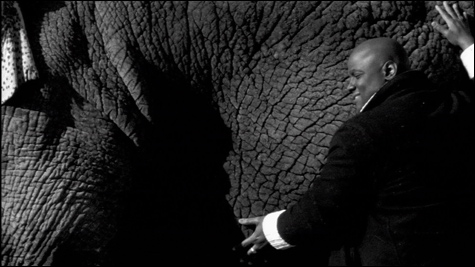
LETTER ON THE BLIND, FOR THE USE OF THOSE WHO SEE If you're going for special effects, you might as well go for the elephant. |
Javier Téllez's 2007 black-and-white film Letter on the Blind, For the Use of Those Who See starts with a catchy premise: he gathered six blind New Yorkers at an empty public pool in Brooklyn to act out the fable of the blind men and the elephant. It was one of the more memorable pieces in last year's Whitney Biennial, and it's the highlight of "Acting Out: Social Experiments in Video" at the Institute of Contemporary Art. It's hard to go | "ACTING OUT: SOCIAL EXPERIMENTS IN VIDEO" | Institute of Contemporary Art, 100 Northern Ave, Boston | through October 18 | "MOMENTUM 13: EILEEN QUINLAN" | Institute of Contemporary Art | through July 12 |
wrong with an elephant.Here ICA curator Jen Mergel collects videos by five artists to frame a trend of artists staging "social experiments" that they hope will yield insights into life and politics and society and what not. These pieces are like arty versions of the manufactured moments and stunt contests of reality TV — and another sign of reality TV's global hegemony. Like American Idol or Survivor or Colonial House, the projects become their own creatures; not about real life exactly, they're documentaries of the behavior of people in contrived situations, a genre that offers its own strange fascinations and insights.

Born in Venezuela and now based on Long Island, Téllez got the idea for his 28-minute film from the old tale where each of a group of blind men feels a different part of an elephant and comes to his own conclusion about what he's touching (leg = pillar, tail = rope, trunk = tree branch, ear = fan, belly = wall). Each man is correct about his fraction of the whole; each is wrong about what it adds up to. The story is told as a lesson of how the truth can be conveyed in different ways, of how we individually glimpse a different slice of a big cosmic reality, of how our different views of the whole can lead to disputes among those who insist that their part is the whole or at least the essential part. As an artwork, "Letter on the Blind" is about the slippery nature of vision, of perception.
Its format is repetitive: shot of blind person, he gets up, he feels elephant, voice-over about elephant, voice-over about being blind, repeat with next participant. "It felt like a tire, a car tire, except it was warm. It wasn't a good feeling." "When I first went to touch it, I bumped into it, and I thought it was the wall. It felt like thick lizard skin." "I felt an ear that felt like a hat and a trunk that felt like a hand." "You feel the ridges and the bumps. And you can feel the life pulsing through it. You can't hide it." "It felt like I was touching some curtains." "I imagined it to be quite large, but I couldn't really sense how wide or tall it was. . . . And then I couldn't tell if the damn thing was breathing or not breathing."
They add their impressions of being blind. "One night I go to sleep, then I wake up the next morning and I can't see anything. The reason? Nobody knows." "There's no concept of light and dark. . . . Some people want their sight back; I don't want it because I don't want to learn a whole new way of living again." "It's like looking through the windshield of a car in fog."
The voice-overs are interesting, but it all comes down to the elephant. I mean, much of the power of this video comes down to Téllez's budget — get a big enough grant (he was commissioned by New York's Creative Time) and you can rent your very own elephant. Some might complain that you're resorting to easy special effects. But if that's the way you're going to go, you might as well go for the elephant.
There's a magic and majesty and poetry to the animal. Watching Letter on the Blind, you imagine yourself in the subjects' place, your hand feeling that wrinkly skin.
British artist Phil Collins (not the pop star) embraces the artificiality of this sort of staged situation in his eight-minute recap of a laughing competition (who can laugh longest) that he organized, with about a half-dozen contestants laughing all at once. One by one the contestants drop out. The laughs start out goofy but become inane, absurd, and finally creepy. A 16-year-old blonde triumphs by laughing for an hour and 44 minutes.